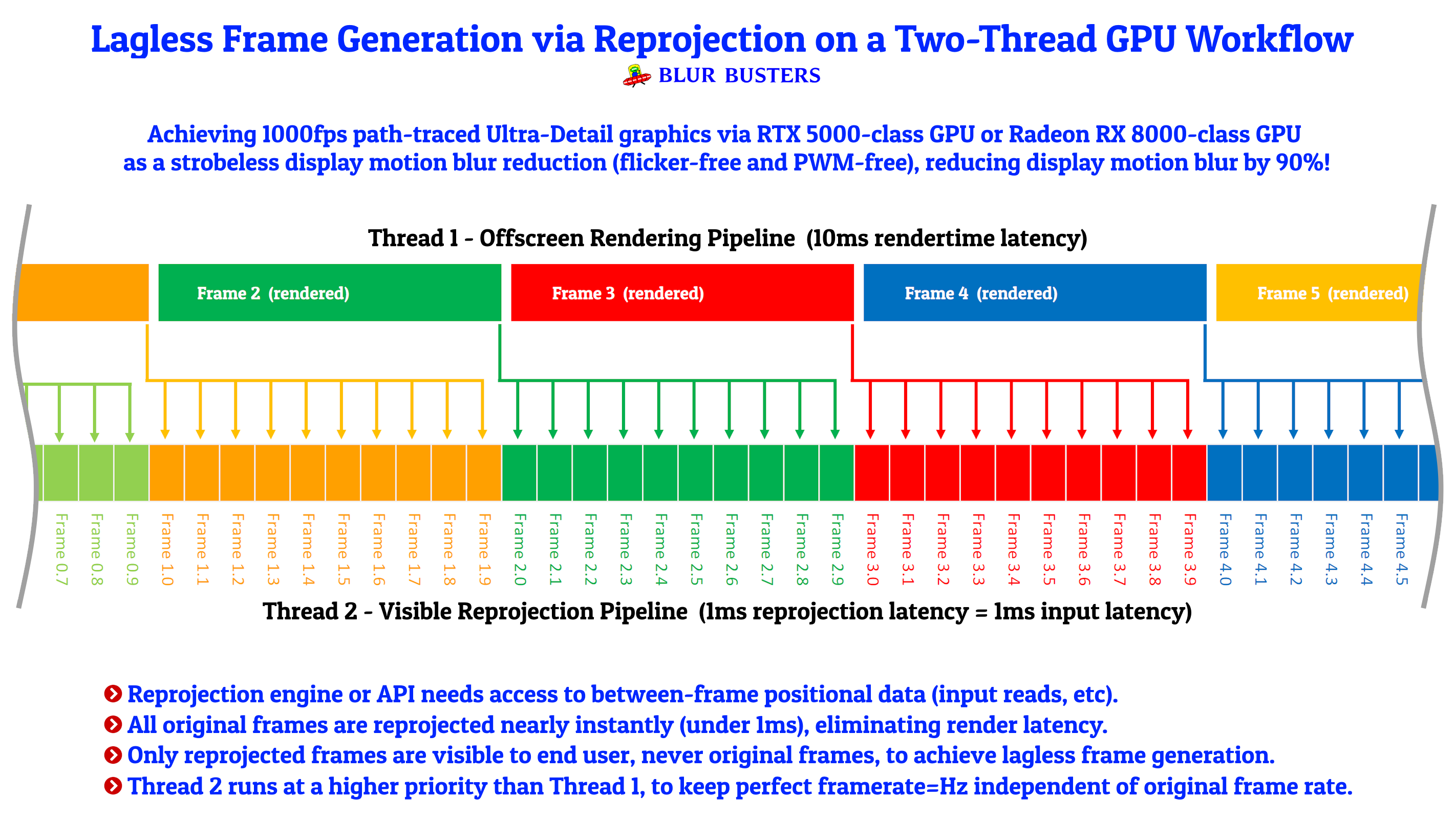Chief Blur Buster wrote: ↑14 Aug 2025, 13:04
It's an interesting concept; I wrote about display-side co-GPU concept about ten years ago in one of my articles, so this is not a new idea.
Yes, your articles are incredibly detailed with so many ideas/concepts it´s sometimes difficult to keep track of the information on blur busters, it could be that I read about it the past. If so sorry, I don´t want to steal your ideas.
@natalie I understand many people don´t like Framegen much, due to latency but one could also go like FSR in the monitor.
Here is a small mini specc:
In-Monitor Upscale + Frame-Gen (IMUF) — Mini-Spec v0.1
Goal: Drive a 4K panel at 500–1000 Hz with perceptually lagless motion using commodity links by transporting a lighter base stream (e.g., 1440p@240–300 Hz) and doing FSR-style upscaling + ×2–×4 reprojection in the monitor, with optional BFI.
1) Transport & Bandwidth
Performance Transport Mode (PTM): GPU sends a lower-res, high-Hz stream over DP 2.1/HDMI 2.1; monitor advertises capability via EDID vendor block (see §4).
Relative pixel-rate table (vs 4K@250 Hz = 100%)
Base stream Relative pixels/sec Notes
4K@250 Hz 100% Reference (too heavy without DSC)
1440p@250 Hz 44% Sweet spot for quality/latency
1440p@300 Hz 53% Extra headroom for reprojection
1080p@360 Hz 35% Budget GPUs / esports focus
DSC may be used on the link; PTM does not require DSC to function.
2) In-Monitor Processing Pipeline
GPU MONITOR (SoC/NPU/DSP) PANEL
Base frames @ PTM ──► [Line buf] ─► Upscale (FSR-like) ─► Reproject ×2–×4 ─► OD/BFI ─► Scanout @ 500–1000 Hz
(e.g., 1440p@300) ~0.1ms 0.3–0.7ms 0.3–0.6ms 0.05–0.1ms (rolling)
Latency budget (target end-to-end added): ≤ ~1.2 ms
Line-buffered upscale to avoid full-frame queues.
Reprojection fed by motion vectors + (optional) depth/occlusion mask when available; otherwise fall back to optical flow.
BFI (optional): single-strobe per generated frame; PWM-free; user-tunable duty.
Artifact plan
Disocclusions/ghosting: clamp vectors at depth edges; blend from native samples; hole-fill with spatial taps.
Overdrive sync: OD solver consumes generated subframes to prevent smear.
VRR: Base stream remains VRR; reprojection smooths between intervals.
3) Sideband “Ground-Truth” Metadata (optional, recommended)
Per-frame packet (sent alongside base frame):
MV grid: 8×8 or 16×16 macroblocks, (vx, vy) as 16-bit fixed-point each.
Depth/occlusion mask: 8-bit, same grid (0–255 = near→far).
Exposure/jitter info: for TAA-style recon.
Frame ID & timestamps: 32-bit each (sync/latency calc).
Transport options (vendor-agnostic):
DP secondary data channel / sideband payload;
HDMI infoframe extension;
AUX/I²C mailbox for capability + small state.
Monitor must gracefully degrade to MV-from-optical-flow if sideband is absent.
4) EDID / Capability Advertisement (vendor block sketch)
Tag: IMUF
Fields:
upscale_modes: {1440p→4K, 1080p→4K}
framegen_multipliers: {×2, ×3, ×4}
max_reprojection_latency_ms: e.g., 1.0
bfi_support: {off, low, med}
mv_sideband: {required, optional, none}
vrr_passthrough: {yes/no}
color_depth_supported: {8/10/12bpc}
optical_flow_fallback: {yes/no}
Driver toggles PTM if IMUF is present and chosen in OSD or control panel.
5) Quality/Perf Targets
Motion clarity: ≥90% blur reduction vs 240 Hz baseline (with BFI on).
Inst. latency add: ≤1.2 ms at 4K×1000 Hz target.
Jitter/tearing: none; VRR-safe.
Failure modes: clear OSD status if sideband missing, flow confidence low, or reprojection disabled.
6) Prototype Path
PC-side PoC: two-thread render (native) + reprojection (visible) to prove lagless feel.
Firmware port: move upscale/reprojection to monitor SoC/NPU; wire up sideband; expose EDID IMUF.
A/B tests: artifact sweeps (pan/scroll/rotation), OD tuning, BFI comfort.
